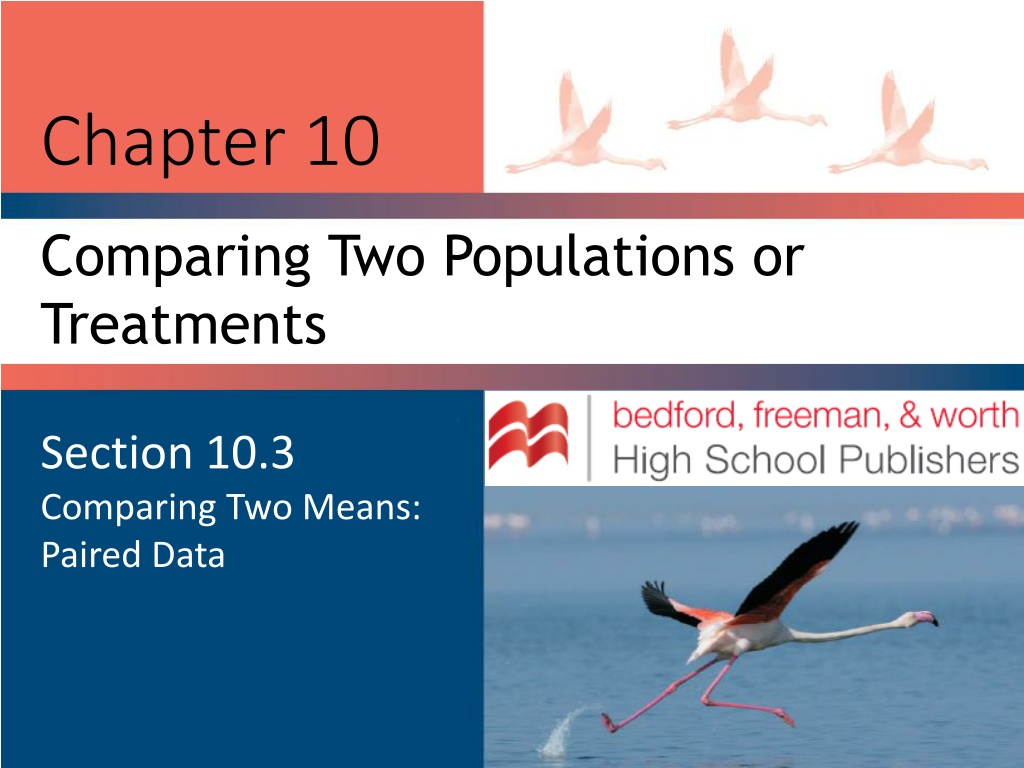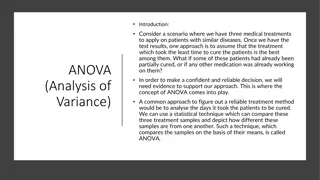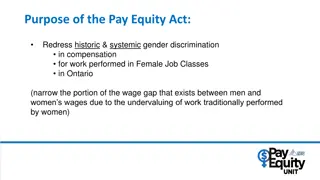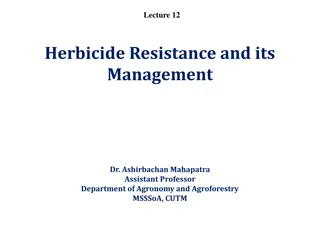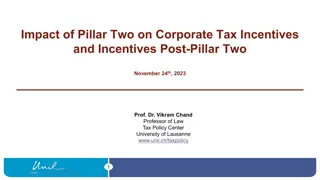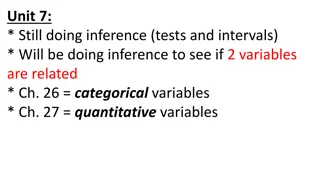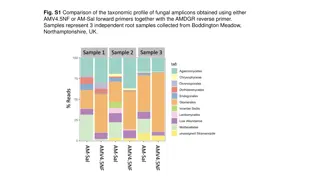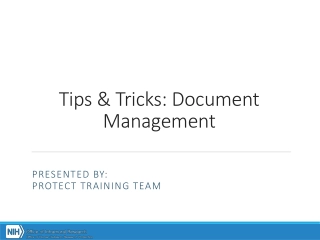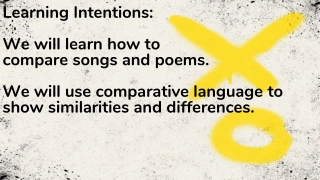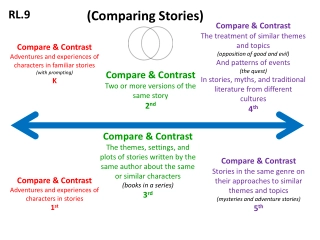Chapter 10.Comparing Two Populations or Treatments
In a study of identical twins raised in high-income and low-income households, researchers compared IQ scores between the siblings. The analysis revealed that twins from high-income households had a higher mean IQ of 109.5 compared to 103.667 for those raised in low-income households. Although there was variability in IQ scores within each group, the difference in means did not appear to be statistically significant due to considerable overlap between the two groups. This research highlights the importance of exploring paired data sets when comparing populations or treatments to draw meaningful conclusions.
Download Presentation
Please find below an Image/Link to download the presentation.
The content on the website is provided AS IS for your information and personal use only. It may not be sold, licensed, or shared on other websites without obtaining consent from the author. Download presentation by click this link. If you encounter any issues during the download, it is possible that the publisher has removed the file from their server.
Presentation Transcript
Chapter 10 Comparing Two Populations or Treatments Section 10.3 Comparing Two Means: Paired Data
Comparing Two Means: Paired Data LEARNING TARGETS By the end of this section, you should be able to: ANALYZE the distribution of differences in a paired data set using graphs and summary statistics. CONSTRUCT and INTERPRET a confidence interval for a mean difference. PERFORM a significance test about a mean difference. DETERMINE when it is appropriate to use paired t procedures versus two-sample t procedures. Starnes/Tabor, The Practice of Statistics
Analyzing Paired Data A researcher studied a random sample of identical twins who had been separated and adopted at birth. In each case, one twin (Twin A) was adopted by a high-income family and the other (Twin B) by a low-income family. Both twins were given an IQ test as adults. Starnes/Tabor, The Practice of Statistics
Analyzing Paired Data A researcher studied a random sample of identical twins who had been separated and adopted at birth. In each case, one twin (Twin A) was adopted by a high-income family and the other (Twin B) by a low-income family. Both twins were given an IQ test as adults. Starnes/Tabor, The Practice of Statistics
Analyzing Paired Data Starnes/Tabor, The Practice of Statistics
Analyzing Paired Data Twins raised in high income households had a higher mean IQ ??=109.5 versus ??=103.667. Starnes/Tabor, The Practice of Statistics
Analyzing Paired Data Twins raised in high income households had a higher mean IQ ??=109.5 versus ??=103.667. There is a similar amount of variability in IQ scores for these two groups of twins: ??=9.47 and ??=8.66 Starnes/Tabor, The Practice of Statistics
Analyzing Paired Data Twins raised in high income households had a higher mean IQ ??=109.5 versus ??=103.667. There is a similar amount of variability in IQ scores for these two groups of twins: ??=9.47 and ??=8.66 But with so much overlap between the groups, the difference in means does not seem statistically significant. Starnes/Tabor, The Practice of Statistics
Analyzing Paired Data The previous analysis ignores the fact that these are paired data. Starnes/Tabor, The Practice of Statistics
Analyzing Paired Data The previous analysis ignores the fact that these are paired data. Paired data result from recording two values of the same quantitative variable for each individual or for each pair of similar individuals. Starnes/Tabor, The Practice of Statistics
Analyzing Paired Data The previous analysis ignores the fact that these are paired data. Paired data result from recording two values of the same quantitative variable for each individual or for each pair of similar individuals. Starnes/Tabor, The Practice of Statistics
Analyzing Paired Data The previous analysis ignores the fact that these are paired data. Paired data result from recording two values of the same quantitative variable for each individual or for each pair of similar individuals. The mean difference is ????? = 5.833 points Starnes/Tabor, The Practice of Statistics
Analyzing Paired Data The previous analysis ignores the fact that these are paired data. Paired data result from recording two values of the same quantitative variable for each individual or for each pair of similar individuals. The mean difference is ????? = 5.833 points ????? = 3.93 points Starnes/Tabor, The Practice of Statistics
Analyzing Paired Data CAUTION: Remember: The proper method of analysis depends on how the data are produced. Starnes/Tabor, The Practice of Statistics
Analyzing Paired Data CAUTION: Remember: The proper method of analysis depends on how the data are produced. Analyzing Paired Data To analyze paired data, start by computing the difference for each pair. Then make a graph of the differences. Use the mean difference ????? and the standard deviation of the differences sdiff as summary statistics. Starnes/Tabor, The Practice of Statistics
Analyzing Paired Data Problem: Does music help or hinder performance in math? Student researchers Abigail, Carolyn, and Leah designed an experiment using 30 student volunteers to find out. Each subject completed a 50-question single-digit arithmetic test with and without music playing. For each subject, the order of the music and no music treatments was randomly assigned, and the time to complete the test in seconds in seconds was recorded for each treatment. Here are the data, along with the difference in time for each subject: gawrav/Getty Images Starnes/Tabor, The Practice of Statistics
Analyzing Paired Data Problem: (a) Make a dotplot of the difference (Music Without music) in time for each subject to complete the test. (b) Describe what the graph reveals about whether music helps or hinders math performance. (c) Calculate the mean difference and the standard deviation of the differences. Interpret the mean difference. gawrav/Getty Images Starnes/Tabor, The Practice of Statistics
Analyzing Paired Data Problem: (a) Make a dotplot of the difference (Music Without music) in time for each subject to complete the test. (b) Describe what the graph reveals about whether music helps or hinders math performance. (c) Calculate the mean difference and the standard deviation of the differences. Interpret the mean difference. gawrav/Getty Images (a) Starnes/Tabor, The Practice of Statistics
Analyzing Paired Data Problem: (a) Make a dotplot of the difference (Music Without music) in time for each subject to complete the test. (b) Describe what the graph reveals about whether music helps or hinders math performance. (c) Calculate the mean difference and the standard deviation of the differences. Interpret the mean difference. gawrav/Getty Images (b) There is some evidence that music hinders performance on the math test. 17 of the 30 subjects took longer to complete the test when listening to music. Starnes/Tabor, The Practice of Statistics
Analyzing Paired Data Problem: (a) Make a dotplot of the difference (Music Without music) in time for each subject to complete the test. (b) Describe what the graph reveals about whether music helps or hinders math performance. (c) Calculate the mean difference and the standard deviation of the differences. Interpret the mean difference. gawrav/Getty Images (c) ?????= ?????? ??? ???= 2.8 seconds ?????= ?????? ??? ???= 7.49 seconds The time it took these 30 students to complete the arithmetic quiz with music was 2.8 seconds longer, on average, than the time it took without the music. Starnes/Tabor, The Practice of Statistics
Analyzing Paired Data There are two ways that a statistical study involving a single quantitative variable can yield paired data: Starnes/Tabor, The Practice of Statistics
Analyzing Paired Data There are two ways that a statistical study involving a single quantitative variable can yield paired data: 1. Researchers can record two values of the variable for each individual. (experiment investigating whether music helps or hinders learning) Starnes/Tabor, The Practice of Statistics
Analyzing Paired Data There are two ways that a statistical study involving a single quantitative variable can yield paired data: 1. Researchers can record two values of the variable for each individual. (experiment investigating whether music helps or hinders learning) 2. The researcher can form pairs of similar individuals and record the value of the variable once for each individual. (observational study of identical twins IQ scores) Starnes/Tabor, The Practice of Statistics
Analyzing Paired Data There are two ways that a statistical study involving a single quantitative variable can yield paired data: 1. Researchers can record two values of the variable for each individual. (experiment investigating whether music helps or hinders learning) 2. The researcher can form pairs of similar individuals and record the value of the variable once for each individual. (observational study of identical twins IQ scores) It is also possible to carry out a matched pairs experiment using Method 2 if the researcher forms pairs of similar subjects and randomly assigns each treatment to exactly one member of every pair. Starnes/Tabor, The Practice of Statistics
Confidence Intervals for diff Conditions for Constructing a Confidence Interval About a Mean Difference Random: Paired data come from a random sample from the population of interest or from a randomized experiment. 10%: When sampling without replacement, ndiff < 0.10Ndiff. Normal/Large Sample: The population distribution of differences (or the true distribution of differences in response to the treatments) is Normal or the number of differences in the sample is large (ndiff 30). If the population (true) distribution of differences has unknown shape and the number of differences in the sample is less than 30, a graph of the sample differences shows no strong skewness or outliers. Starnes/Tabor, The Practice of Statistics
Confidence Intervals for diff One-Sample t Interval for a Mean Difference (Paired t Interval for a Mean Difference) When the conditions are met, a C% confidence interval for diff is ????? ? ????? ????? where t* is the critical value with C% of the area between t* and t* for the t distribution with ndiff 1 degrees of freedom. Starnes/Tabor, The Practice of Statistics
Confidence Intervals for diff Problem: The data from the random sample of identical twins are shown again in the following table. Construct and interpret a 95% confidence interval for the true mean difference in IQ scores among twins raised in high-income and low-income households. Jodi Cobb/Getty Images Starnes/Tabor, The Practice of Statistics
Confidence Intervals for diff Problem: The data from the random sample of identical twins are shown again in the following table. Construct and interpret a 95% confidence interval for the true mean difference in IQ scores among twins raised in high-income and low-income households. Jodi Cobb/Getty Images STATE 95% CI for diff where diff = the true mean difference (High income Low income) in IQ scores for pairs of identical twins raised in separate households. Starnes/Tabor, The Practice of Statistics
Confidence Intervals for diff Problem: The data from the random sample of identical twins are shown again in the following table. Construct and interpret a 95% confidence interval for the true mean difference in IQ scores among twins raised in high-income and low-income households. Jodi Cobb/Getty Images PLAN One-sample t interval for diff Random: Random sample of 12 pairs of identical twins, one raised in a high-income household and the other in a low-income household. separate households. 10%: Assume 12 < 10% of all pairs of identical twins raised in Starnes/Tabor, The Practice of Statistics
Confidence Intervals for diff Problem: The data from the random sample of identical twins are shown again in the following table. Construct and interpret a 95% confidence interval for the true mean difference in IQ scores among twins raised in high-income and low-income households. Jodi Cobb/Getty Images PLAN Normal/Large Sample? The number of differences is small, but the dotplot doesn t show any strong skewness or outliers. Starnes/Tabor, The Practice of Statistics
Confidence Intervals for diff Problem: The data from the random sample of identical twins are shown again in the following table. Construct and interpret a 95% confidence interval for the true mean difference in IQ scores among twins raised in high-income and low-income households. Jodi Cobb/Getty Images DO ?????= 5.833, df = 12 1 = 11, so t* = 2.201 ?????= 3.93, ?????= 12 5.833 2.2013.93 12 = 5.833 2.497 = (3.336,8.330) Starnes/Tabor, The Practice of Statistics
Confidence Intervals for diff Problem: The data from the random sample of identical twins are shown again in the following table. Construct and interpret a 95% confidence interval for the true mean difference in IQ scores among twins raised in high-income and low-income households. Jodi Cobb/Getty Images CONCLUDE We are 95% confident that the interval from 3.336 to 8.330 captures the true mean difference (High income Low income) in IQ scores among pairs of identical twins raised in separate households. Starnes/Tabor, The Practice of Statistics
Significance Tests for diff H0: diff = hypothesized value Starnes/Tabor, The Practice of Statistics
Significance Tests for diff H0: diff = 0 H0: diff = hypothesized value Starnes/Tabor, The Practice of Statistics
Significance Tests for diff H0: diff = 0 H0: diff = hypothesized value Conditions for Performing a Significance Test About a Mean Difference Random: Random: Paired data come from a random sample from the population of interest or from a randomized experiment. 10%: When sampling without replacement, ndiff < 0.10Ndiff. Normal/Large Sample: The population distribution of differences (or the true distribution of differences in response to the treatments) is Normal or the number of differences in the sample is large (ndiff 30). If the population (true) distribution of differences has unknown shape and the number of differences in the sample is less than 30, a graph of the sample differences shows no strong skewness or outliers. Starnes/Tabor, The Practice of Statistics
Significance Tests for diff One-Sample t Test for a Mean Difference (Paired t Test for a Mean Difference) Suppose the conditions are met. To test the hypothesis H0: diff = 0, compute the standardized test statistic, ????? 0 ????? ????? ? = Find the P-value by calculating the probability of getting a t statistic this large or larger in the direction specified by the alternative hypothesis Ha. Use the t distribution with ndiff 1 degrees of freedom. Starnes/Tabor, The Practice of Statistics
Significance Tests for diff Problem: Researchers designed an experiment to study the effects of caffeine withdrawal. They recruited 11 volunteers who were diagnosed as being caffeine dependent to serve as subjects. Each subject was barred from coffee, colas, and other substances with caffeine for the duration of the experiment. During one 2-day period, subjects took capsules containing their normal caffeine intake. During another 2-day period, they took placebo capsules. The order in which subjects took caffeine and the placebo was randomized. At the end of each 2-day period, a test for depression was given to all 11 subjects. Researchers wanted to know whether being deprived of caffeine would lead to an increase in depression. he table displays data on the subjects depression test scores. Higher scores show more symptoms of depression. MrPants/Getty Images Starnes/Tabor, The Practice of Statistics
Significance Tests for diff Problem: Do the data provide convincing evidence at the = 0.05 significance level that caffeine withdrawal increases depression score, on average, for subjects like the ones in this experiment? MrPants/Getty Images Starnes/Tabor, The Practice of Statistics
Significance Tests for diff Problem: Do the data provide convincing evidence at the = 0.05 significance level that caffeine withdrawal increases depression score, on average, for subjects like the ones in this experiment? MrPants/Getty Images STATE H0: diff = 0 Ha: diff > 0 diff = the true mean difference (Placebo Caffeine) in depression test score for subjects like these. Because no significance level is given, we ll use = 0.05. Starnes/Tabor, The Practice of Statistics
Significance Tests for diff Problem: Do the data provide convincing evidence at the = 0.05 significance level that caffeine withdrawal increases depression score, on average, for subjects like the ones in this experiment? MrPants/Getty Images PLAN Paired t test for diff Random: Researchers randomly assigned the treatments placebo then caffeine, caffeine then placebo to the subjects. Normal/Large Sample: The sample size is small, but the histogram of differences doesn t show any outliers or strong skewness. Starnes/Tabor, The Practice of Statistics
Significance Tests for diff Problem: Do the data provide convincing evidence at the = 0.05 significance level that caffeine withdrawal increases depression score, on average, for subjects like the ones in this experiment? MrPants/Getty Images DO ?????= 7.364, ?????= 6.918, ?????= 11 7.364 0 6.918 11 ?? = 11 1 = 10 Table B: P-value is between 0.0025 and 0.005. Technology: tcdf(lower: 3.53, upper: 1000, df: 10) = 0.0027 ? = = 3.53 Starnes/Tabor, The Practice of Statistics
Significance Tests for diff Problem: Do the data provide convincing evidence at the = 0.05 significance level that caffeine withdrawal increases depression score, on average, for subjects like the ones in this experiment? MrPants/Getty Images CONCLUDE Because the P-value of 0.0027 < = 0.05, we reject H0. We have convincing evidence that caffeine withdrawal increases depression test score, on average, for subjects like the ones in this experiment. Starnes/Tabor, The Practice of Statistics
Paired Data or Two Samples? Two-sample t procedures require data that come from independent random samples from the two populations of interest or from two groups in a randomized experiment. 1 2 Starnes/Tabor, The Practice of Statistics
Paired Data or Two Samples? Two-sample t procedures require data that come from independent random samples from the two populations of interest or from two groups in a randomized experiment. 1 2 Paired t procedures require paired data that come from arandom sample from the population of interest or from a randomized experiment. diff Starnes/Tabor, The Practice of Statistics
Paired Data or Two Samples? Two-sample t procedures require data that come from independent random samples from the two populations of interest or from two groups in a randomized experiment. 1 2 Paired t procedures require paired data that come from arandom sample from the population of interest or from a randomized experiment. diff CAUTION: The proper inference method depends on how the data were produced. Starnes/Tabor, The Practice of Statistics
Paired Data or Two Samples? Problem: In each of the following settings, decide whether you should use two- sample t procedures to perform inference about a difference in means or paired t procedures to perform inference about a mean difference. Explain your choice. (a) Before exiting the water, scuba divers remove their fins. A maker of scuba equipment advertises a new style of fins that is supposed to be faster to remove. A consumer advocacy group suspects that the time to remove the new fins may be no different than the time required to remove old fins, on average. Twenty experienced scuba divers are recruited to test the new fins. Each diver flips a coin to determine if they wear the new fin on the left foot and the old fin on the right foot, or vice versa. The time to remove each type of fin is recorded for every diver. Starnes/Tabor, The Practice of Statistics
Paired Data or Two Samples? Problem: In each of the following settings, decide whether you should use two- sample t procedures to perform inference about a difference in means or paired t procedures to perform inference about a mean difference. Explain your choice. (a) Before exiting the water, scuba divers remove their fins. A maker of scuba equipment advertises a new style of fins that is supposed to be faster to remove. A consumer advocacy group suspects that the time to remove the new fins may be no different than the time required to remove old fins, on average. Twenty experienced scuba divers are recruited to test the new fins. Each diver flips a coin to determine if they wear the new fin on the left foot and the old fin on the right foot, or vice versa. The time to remove each type of fin is recorded for every diver. Paired t procedures. The data come from two measurements of the same variable (time to remove fin) for each diver. Starnes/Tabor, The Practice of Statistics
Paired Data or Two Samples? Problem: In each of the following settings, decide whether you should use two- sample t procedures to perform inference about a difference in means or paired t procedures to perform inference about a mean difference. Explain your choice. (b) To study the health of aquatic life, scientists gathered a random sample of 60 White Piranha fish from a tributary of the Amazon River during one year. The average length of these fish was compared to a random sample of 82 White Piranha from the same tributary a decade ago. Starnes/Tabor, The Practice of Statistics
Paired Data or Two Samples? Problem: In each of the following settings, decide whether you should use two- sample t procedures to perform inference about a difference in means or paired t procedures to perform inference about a mean difference. Explain your choice. (b) To study the health of aquatic life, scientists gathered a random sample of 60 White Piranha fish from a tributary of the Amazon River during one year. The average length of these fish was compared to a random sample of 82 White Piranha from the same tributary a decade ago. Two-sample t procedures. The data come from independent random samples of White Piranha in two different years. Starnes/Tabor, The Practice of Statistics
Paired Data or Two Samples? Problem: In each of the following settings, decide whether you should use two- sample t procedures to perform inference about a difference in means or paired t procedures to perform inference about a mean difference. Explain your choice. (c) Can a wetsuit deter shark attacks? A researcher has designed a new wetsuit with color variations that are suspected to deter shark attacks. To test this idea, she fills two identical drums with bait and covers one in the standard black neoprene wetsuit and the other in the new suit. Over a period of one week, she selects 16 two-hour time periods and randomly assigns 8 of them to the drum in the black wetsuit. The other 8 are assigned to the drum with the new suit. During each time period, the appropriate drum is submerged in waters that sharks frequent and the number of times a shark bites the drum is recorded. Starnes/Tabor, The Practice of Statistics
